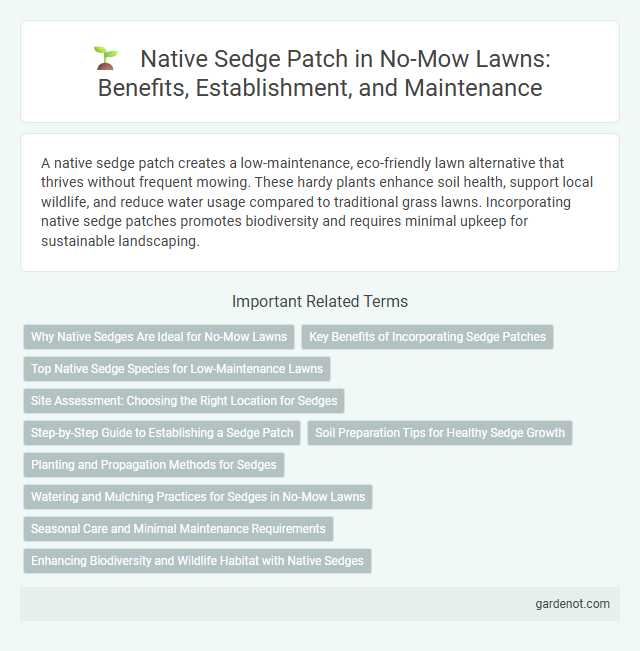A native sedge patch creates a low-maintenance, eco-friendly lawn alternative that thrives without frequent mowing. These hardy plants enhance soil health, support local wildlife, and reduce water usage compared to traditional grass lawns. Incorporating native sedge patches promotes biodiversity and requires minimal upkeep for sustainable landscaping.
Why Native Sedges Are Ideal for No-Mow Lawns
Native sedges thrive in no-mow lawns due to their low-growth habit and deep root systems, which enhance soil stability and reduce erosion. These grasses require minimal maintenance, eliminating the need for frequent mowing, watering, or fertilizing, and adapt well to various soil types and light conditions. Their biodiversity benefits support local ecosystems by providing habitat for pollinators and improving lawn resilience against pests and drought.
Key Benefits of Incorporating Sedge Patches
Native sedge patches enhance no-mow lawns by providing low-maintenance ground cover that requires minimal watering and mowing, reducing overall lawn care time and resource consumption. These sedges improve soil health through dense root systems that prevent erosion and support beneficial microbial activity, fostering a resilient lawn ecosystem. Their adaptability to various soil types and resistance to pests further ensure sustainable, long-term lawn vitality with natural biodiversity benefits.
Top Native Sedge Species for Low-Maintenance Lawns
Top native sedge species such as Carex flacca, Carex pennsylvanica, and Carex scoparia create durable, low-maintenance lawns that thrive without frequent mowing. These sedges offer drought tolerance, shade adaptability, and erosion control, making them ideal for sustainable, water-efficient landscapes. Establishing native sedge patches promotes biodiversity while significantly reducing the need for fertilizers and pesticides.
Site Assessment: Choosing the Right Location for Sedges
Native sedge patches thrive in moist, well-drained soils often found in shaded or partially shaded areas, making site assessment critical for their success in no-mow lawns. Evaluating soil texture, moisture levels, and sunlight exposure ensures optimal growth conditions and minimizes maintenance needs. Proper site selection enhances sedge establishment, promotes biodiversity, and supports sustainable landscaping practices.
Step-by-Step Guide to Establishing a Sedge Patch
Establish a native sedge patch by first selecting a shaded or partially shaded area with moist, well-drained soil. Prepare the site by removing existing grass and weeds, then plant sedge plugs or seeds spaced 12-18 inches apart to allow room for growth. Maintain consistent moisture during the establishment period and avoid mowing to encourage dense, healthy sedge growth in your no-mow lawn.
Soil Preparation Tips for Healthy Sedge Growth
For healthy native sedge growth in a no-mow lawn, soil preparation begins with assessing and improving drainage, as sedges thrive in moist, well-drained soils. Incorporate organic matter such as compost to enhance soil fertility and structure, promoting robust root development and nutrient uptake. Ensure the soil pH is slightly acidic to neutral, ideally between 5.5 and 7.0, to support optimal sedge establishment and growth.
Planting and Propagation Methods for Sedges
Native sedge patches thrive when planted using division or seed propagation methods, ensuring healthy root establishment and optimal growth. Division involves carefully separating clumps in early spring or fall, while seed propagation requires sowing fresh seeds in moist, well-drained soil for successful germination. Proper site preparation with minimal soil disturbance enhances the establishment and spread of sedges in no-mow lawn ecosystems.
Watering and Mulching Practices for Sedges in No-Mow Lawns
Native sedge patches in no-mow lawns benefit from minimal watering, as these plants are highly drought-tolerant and adapted to local rainfall patterns, reducing the need for supplemental irrigation. Applying a light layer of organic mulch around sedges helps retain soil moisture, suppress weed growth, and moderate soil temperature without suffocating the roots. Proper mulching and controlled watering practices promote healthy root development and sustainability in native sedge patches within no-mow lawn systems.
Seasonal Care and Minimal Maintenance Requirements
Native sedge patches thrive with minimal maintenance, requiring only seasonal care such as light watering during dry spells and occasional removal of dead foliage in early spring. These low-maintenance grasses naturally suppress weeds, reducing the need for mowing or chemical treatments. Their resilience to drought and pests makes them an eco-friendly choice for sustainable, no-mow lawns.
Enhancing Biodiversity and Wildlife Habitat with Native Sedges
Native sedge patches significantly enhance biodiversity by providing essential habitats for various pollinators, birds, and small mammals, promoting a balanced and thriving ecosystem. Their robust root systems improve soil health and water retention, supporting native plant communities and reducing erosion. Incorporating native sedges into no-mow lawns fosters wildlife corridors and contributes to sustainable, low-maintenance landscapes.
Native sedge patch Infographic

 gardenot.com
gardenot.com